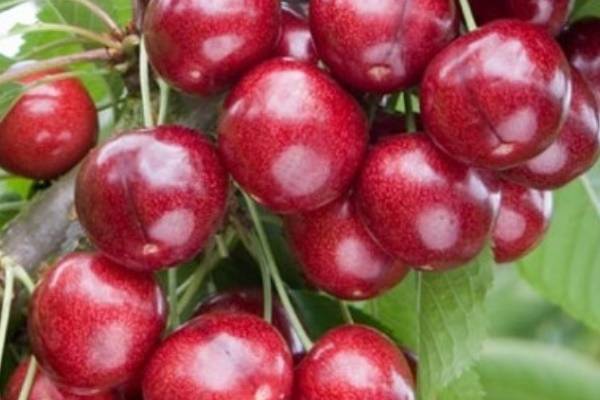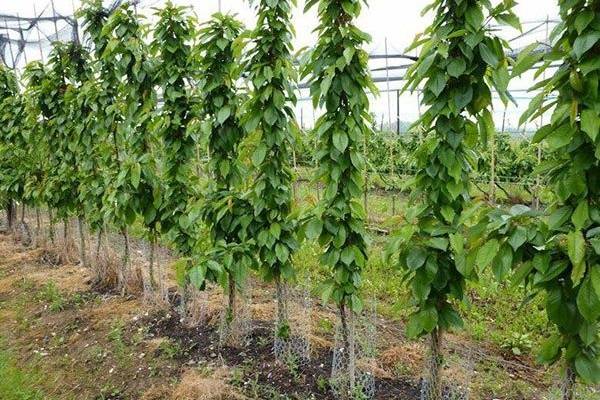Content
In the gardens of the Russian Federation, a new type of fruit plants has recently appeared - columnar trees. During this period, a lot of positive feedback about this culture was received from gardeners. Cherry Helena is a compact plant with a bush height (no more than 3.5 m). Giving a bountiful harvest and decorating the garden, it is popular in central Russia. It is characterized by the dessert taste of red-pink berries. Photo of cherry Helena:
Breeding history
Columnar trees are of Canadian origin. One of the farmers in 1964 discovered a mutation of the apple tree, characterized by increased fertility in the absence of a crown. The breeding of fruit crops with this trait was continued in Europe. The results obtained were highlighted and consolidated. Cherry variety Helena is an early hybrid that grows almost only upwards. Acquiring a cylindrical crown, it has short lateral branches with many fruit processes.
Description of culture
The dimensions of the plant are not more than a meter in diameter, and reach 3.5 meters in height. There is no significant branching. Description of the variety columnar cherries Helena, regarding the fruit, classifies it as a dessert variety.
Large berries have the following characteristics:
- Some harshness, external beauty, glossy shine and ruby hue.
- In the dark red juicy pulp of medium density, pink veins are distinguished.
- The taste is very sweet, honeyed with aroma.
- The weight of cherries 12 - 15 grams is an excellent indicator.
Cherry Helena is ideal for growing in the middle lane.
Characteristics
Planting and caring for columnar cherry Helena include the choice of a bright place, sheltered from the wind. If the soil is fertile enough, the best quality fruit can be obtained from the tree.
Drought resistance, winter hardiness
Helena's columnar cherry withstands frosts in the middle zone of the Russian Federation (-40 ° C). In the first two years of life, they cover it for the winter, since the crown of the head can be damaged by the cold. The tree loves watering, which is especially important when forming fruit. To get a good harvest, it is better not to expose it to drought. But cherries will not tolerate stagnant moisture either.
Pollination, flowering period and ripening times
Gardeners know that cherry, as a crop, is, in the overwhelming majority, incapable of self-pollination. For this process, she needs to have a different kind of tree nearby.
Self-fertile Helena can only be partially.
Productivity, fruiting
The harvest in the middle lane ripens on June 18 or 25, which is the average period. More than 15 kg can be harvested from each tree, which is a good indicator. The tree remains fruitful for 15 or 25 years. After planting, Helena cherries take root well. But in the same year, one should not count on fruiting. Some owners pick flowers in the first spring, trying to acclimatize the tree, leave it more energy. You can wait for the harvest in the third year of life.
Disease and pest resistance
The Helena variety is resistant not only to winter, but also to disease. Therefore, and for other reasons, it is considered not requiring onerous maintenance. As a prophylaxis against pests and diseases, at the beginning of the spring, before flowering, the trunks are whitewashed. And also sprayed with Bordeaux liquid.
Advantages and disadvantages
The "pluses" of Helena cherries include the following properties.
- Compact size of the tree.
- Resistant to cold and disease.
- Ripening quite early.
- Sufficient unpretentiousness. Easy to care for, the tree does not require pruning.
- Harvested easily, fruits are available.
- Beautiful, tasty and juicy fruits.
The disadvantage is the low yield compared to full-size trees. And also only partial self-pollination.
Conclusion
Cherry Helena belongs to one of the most beloved types of fruit trees. Its columnar shape is comfortable, the tree is not too tall. The compact size makes the entire crop affordable. Also, such a selection allows you to place several varieties in a small area. Having mastered the methods of growing such cherries, gardeners will have the opportunity to get a stable harvest of delicious berries. And also columnar trees will decorate the site, create an original landscape.
Testimonials
The following reviews were received from gardeners about the Helena columnar cherry.
I have chosen two varieties of columnar cherries for my garden: Sylvia and Helena. Both grow well, but I cover them for the winter. Very tasty fruits, trees are suitable for the climate. I have great reviews of Helena and Sylvia cherries as varieties.











